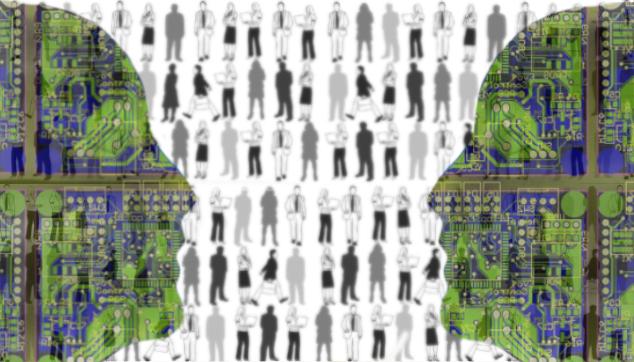Automation and Artificial Intelligence Triggering Massive Layoffs in IT

Newsclick Image by Trina Shankar
Automation is not new to the industrial world. Hundreds of thousands of jobs have been displaced because of advances in automation technology. With the advent of Information Technology (IT), the pace of automation has only increased. IT has enabled the automation of hitherto ‘manual-only’ jobs. And life has come a full circle for IT. There is increasing automation in IT itself. The consequences are similar - large-scale job displacement.
However, there is more to it than only a loss of jobs. Its impact on the society is wide-ranging and is the foundation for behaviour modelling.
Bifurcation of jobs
A special report published by The Economist, “Automation and Anxiety”, states –
‘Economists are already about “job polarisation”, where middle-skill jobs (such as those in manufacturing) are declining but both low-skill and high-skill jobs are expanding. In effect, the workforce bifurcates into two groups doing non-routine work: highly paid, skilled workers (such as architects and senior managers) on the one hand and low-paid, unskilled workers (such as cleaners and burger-flippers) on the other.’
The situation in IT will be no different. More higher-end and lower-end jobs will be created while displacing a large number of mid-level jobs. The likely lower-end jobs that could be created include data-entry. At the other end of the spectrum, jobs will be created to design algorithms which need to be run on the huge.
An example of this is Google maps – a large number of people work on cleansing and entering data collected through different means (satellites, manually collecting, etc). Data scientists and analysts then design algorithms that need to be run on these. Once the algorithms and the data are in place, programs are tuned to learn and modify themselves - eliminating the need for mid-level workers.
However, we should also note that automation will eliminate a lot of low-level jobs as well. First to face this threat will be Level 1 support. Chatbots are increasingly becoming commonplace as the first touch-point for customers. HfS, a market research firm, estimates that between 14 - 22 lakhs low-level jobs will be eliminated by 2021 globally. It might sound paradoxical, but automation will replace a lot of low-level jobs while simultaneously creating a new set of low-level jobs. The jobs which will not be automated are the ones where automation will not be economically beneficial.
Indian Scenario
Multiple surveys and reports portray a gloomy scenario for Indian IT. PeopleStrong, an HR agency, predicts that 23% of all jobs that will be lost to automation will be from India. It also states that IT and IT-es jobs will be the first and hardest hit.
The HfS report estimates that 6,40,000 jobs will be eliminated at the lower-skill level in India, by 2021. At the same time, only 1,60,000 jobs will be created, thereby resulting in a decrease in employment.
And the results are already showing: Tech Mahindra’s headcount dropped by 2,000 in a quarter in 2016 on account of increasing automation. Infosys ‘released’ 9,000 employees to work on more advanced projects since the work they were doing was automated. Capgemini and CTS are in a similar situation.
Indian IT and Artificial Intelligence
Wipro launched the first Artificial Intelligence (AI) platform by an Indian IT firm, Holmes. TCS followed suit with. Infosys launched their platform ‘Mana’ and is now Nia.
Most of the clients for these platforms are Banks and Credit agencies. AI/ML techniques are good at finding frauds - essentially, pattern recognition. The second most popular clients are law firms. These firms use AI platforms to search and validate documents, eliminating the need for clerks.
The most interesting case study comes from Infosys though. And the client is an IT firm. It is more common for automation to replace L1 support. However, AI is already at a stage where even Level 3 support is being automated. Infosys’s Nia has created a system which can do:
• Root Cause Analysis
• Impact Analysis
• Bug localisation
These are all areas where, traditionally, human intervention and creative thinking was required. And L3 support teams form a major part of the workforce of all service organisations. Almost every project will need to provide some level of L3 support - from product enhancements to bug fixes.
This was an area that was not thought to be vulnerable to AI, but it is already under threat. It is not going to be long before other IT firms pick this up.
The Alter-narrative
Re-skilling employees often heard as the solution. However, as the data suggests, mere re-skilling will not be sufficient. More jobs will be lost than will be created. Re-skilling in areas other than IT is a moot point, given that it is IT in the first place which enabled automation in those other areas. However, for a country like India, there is still a lot of to expand into manufacturing. Even though manufacturing itself is heavily taken over by robotics and process automation, it will still ensure employment creation. Fabrication facilities are non-existent in India.
Setting up of data centres in India is another way of increasing employment. One point worth pondering over is about protecting the job market. With the advent of India Stack, there is a chance that we could take the Chinese way and build a protection like the Chinese Firewall.
However, this will only ensure that the domestic firms are firmed up and protected against international competition. The beneficiaries of such a tactic could be the Flipkarts and Olas, but not the employee. Job protection, as a policy, is perhaps one of the methods.
In the next two to three years, there is going to be a large percentage of this workforce which will be retrenched, while the working hours and conditions of the rest are going to be substantially worse off. From policies to technologies to activism - combating this has to take a multi-faceted approach.
Disclaimer: The views expressed here are the author's personal views, and do not necessarily represent the views of Newsclick.
Get the latest reports & analysis with people's perspective on Protests, movements & deep analytical videos, discussions of the current affairs in your Telegram app. Subscribe to NewsClick's Telegram channel & get Real-Time updates on stories, as they get published on our website.
























